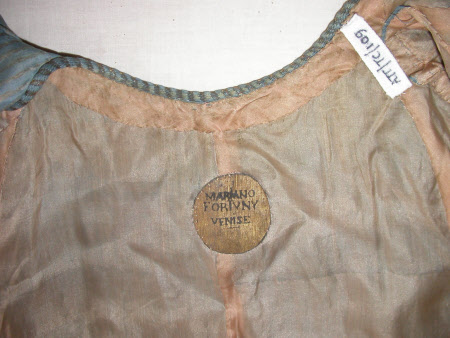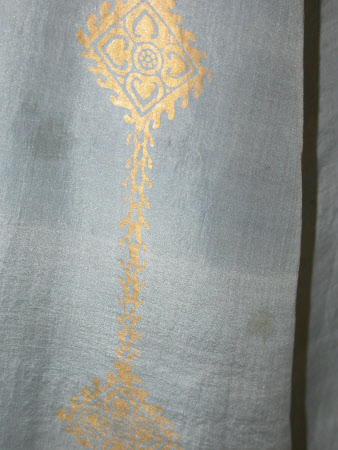Robe
Mariano Fortuny y Madrazo (1871-1949)
Category
Costume
Date
circa 1923
Materials
Silk and glass beads
Measurements
1310 mm (L); 1010 mm (L)
Place of origin
Venice
Order this imageCollection
Attingham Park, Shropshire
NT 609818
Caption
Inspired by traditional Middle Eastern and North African garments, these soft, flowing silk robes were made around 1923 by the Venetian couture house of Mariano Fortuny (1871–1949). Fortuny’s designs revolutionised European fashion by accentuating women’s natural, uncorseted curves. Loose, light and unstructured, the robe’s silk panels are joined together by glass beads that also add weight to the garment, allowing the wearer to achieve a perfectly draped silhouette. The silk was dipped repeatedly in baths of blue dye to develop its striking depth and tone, then stencilled with gold pigment to create a luminous, shimmering effect. The owner of this piece was Teresa Noel-Hill, Lady Berwick (1890–1972), who grew up in Venice among artists and socialites, and later married Lord Berwick (1877–1947) of Attingham Park. Her 1923 portrait by Sir Gerald Kelly (1879–1972) (NT 608972) shows how she chose to wear the robe, accessorised with a fur collar and simple jewellery. Helen Rowse
Summary
This silk evening cloak or robe was made in Venice in the early 20th century. It is associated with Teresa Noel-Hill, Lady Berwick (1890–1972), who gifted it to the National Trust as part of her personal collection of fashion and dress at Attingham Park. It had entered Attingham’s collection by 1923, when Teresa, then in her early thirties, was painted wearing the robe by portrait artist Sir Gerald Kelly RA in the Boudoir at Attingham (see NT 608972). The robe is hand sewn, made from blue-grey silk with a salmon pink silk lining, and richly decorated with hand-stencilled gold pigment. The silk panels are joined with decorative Murano glass beads that add weight to the garment and allow the wearer to achieve a perfectly draped silhouette. The neck of the robe is trimmed with a long blue and grey cord, which can be tied at the front. It was designed and made by the couture house of Mariano Fortuny (1871–1949), founded in Venice in 1906. Fortuny borrowed from a range of sources in his fashion and textile designs, often blending styles and motifs from different cultures and time periods. This garment is a Western European translation of the North African djellaba, an outer robe traditionally worn by traders, often made from wool. Fortuny had visited Morocco in the early 1920s, documenting his travels through mountainous countryside and village marketplaces in a collection of films and photographs now held by Fondazione Musei Civici di Venezia. The stylised vine leaf motifs stencilled in gold pigment along the borders of the garment are inspired by a collection of 3rd-7th century Coptic textiles removed from burial sites in Egypt in the late nineteenth century and purchased by the art historian Eduoard Gerspach (1833-1906) from antiquarian dealers in 1898 and 1899, on behalf of the Gobelins tapestry factory. In 1890, Gerspach published a catalogue titled 'Les Tapisseries Coptes', where over 150 Coptic designs were reproduced. It is likely that Fortuny had access to this book, as it features near-identical matches to two different sections of the robe's stencilled motifs (plates 15 and 65). Together with the French inventor and designer Henriette Nigrin (1877–1965), Mariano Fortuny revolutionised European fashion in the early 20th century by making loose, unstructured garments that accentuated women’s natural, uncorseted curves through artful drapery and innovative silk pleating. Their avant-garde designs were popularised by actresses such as Eleonora Duse and Ellen Terry, who could afford to subvert convention in public. As an upper-class woman married to a member of the English nobility, Teresa navigated a complex set of social expectations around what to wear, and when to wear it. She may have worn this robe at home, or at private informal gatherings among like-minded friends. The Kelly portrait’s appropriate setting, neoclassical furniture and restrained colour palette create a meticulously tailored image, balancing Teresa’s individuality and artistic sensibilities with respect for the tradition and decorum associated with her husband’s title. A decade after Teresa wore the Fortuny cloak in her portrait, in an article called ‘Short Cuts to Good Dressmaking’ published in the Daily Mail in March 1934, she wrote: “Of course, when you try on your dress you will put on the corset and slip which will eventually be worn beneath it,” reflecting the prevailing norms of propriety.
Provenance
8th Lady Berwick collection; bequeathed to the National Trust by Edith Teresa Hulton, Lady Berwick (1890-1972).
Marks and inscriptions
Mariano Fortuny Venice (circular printed fabric label)
Makers and roles
Mariano Fortuny y Madrazo (1871-1949), designer
References
Waterson 1980 Merlin Waterson, 'Lady Berwick, Attingham and Italy', National Trust Studies 1981, 1980, p.65. Gerspach 1980, Eduoard Gerspach, Les Tapisseries Coptes, Paris: Maison Quantin, 1890., Plates 15 and 65. Antrobus and Slocombe 2025: Helen Antrobus and Emma Slocombe, 100 Things to Wear: Fashion from the collections of the National Trust, National Trust 2025, pp. 168-167.


